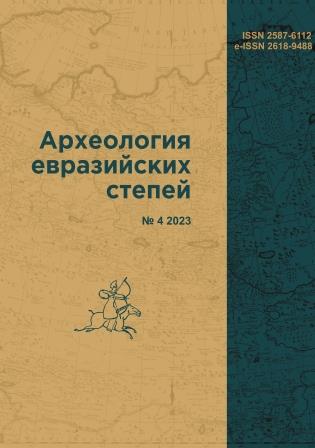Reflection of Zoroastrianism in the Temples of Central Asia of the Bronze Age
DOI:
https://doi.org/10.24852/2587-6112.2023.4.294.301Keywords:
archaeology, Central Asia, Bactria, Margiana, Bronze Age, Avesta, Rigveda, mythology, religion, temple of fire, goddess of the sun, "pavi", "haoma", Sarazm, Altyn-depe, Dashtli, Gonur, Togolok 21, Jarkutan., Sarazm, Altyn-depe, Dashtli, Gonur, Togolok 21, JarkutanAbstract
The acceleration of migration processes in Central Asia in the Bronze Age created an environment of multiculturalism. Cultural links, social and economic progress ensured the further development of the spiritual thinking of society and led to the formation of the so-called Bull civilization. Images associated with fire occupied a special place in the origin of mythological and religious views formed the spiritual basis of this civilization. The formation of fire as a divine symbol in the spiritual world of a human being or directly as a cult has undergone a long historical process. In particular, a large number of religious buildings and rituals, representing the cult of fire in Central Asia, attracts attention. Fire as a symbol of faith was valued not only in the Zoroastrian religion, which is said to have been formed in Central Asia, but also in the earlier Indo-Iranian faith – the Daevayasna religion. The fact that the place of the bonfire was preserved in the beliefs, spread in Central Asia after Zoroastrianism, is reflected in archaeological and ethnographic materials and, above all, in the cult architecture of the Bronze Age. The article deals with the revealing of the stages of the fire cult formation in Central Asia on the basis of archaeological materials and written sources. The study presents various characteristics of fire worship, "fire reverence", the symbol of which is Mitra. The authors also analyze the general and specific features of fire hymns in such sacred sources as the Avesta and the Rigveda, and shows the evolution of the cult of fire by comparing written and material sources.
References
Avesta. Izbrannye gimny (Avesta. Selected hymns). Steblin-Kameskii, I. M. (transl.)., Livshits, V. A. (ed.). Dushanbe: “Adib” Publ. (in Russian).
Avdiev, V. I. 2013. Istoriya Drevnego Vostoka (History of the Ancient East). Moscow: “Ripol Klassik” Publ. (in Russian).
Askarov, A. 2015. Istoriya proiskhozhdeniya uzbekskogo naroda (History of genesis of the Uzbek people). Tashkent: “Uzbekistan” Publ. (in Russian).
Askarov, A. A., Shirinov, T. Sh. 1989. In Pugachenkova, G. A. (ed.). Gradostroitel'stvo i arkhitektura (Urban planning and architecture). Tashkent: “Fan” publ., 23–42 (in Russian).
Askarov, A. A., Shirinov, T. Sh. 1993. Rannyaya gorodskaya kul'tura epokhi bronzy yuga Sredney Azii (The Early Urban Culture of Bronze Age of Southern Uzbekistan). Samarkand (in Russian).
Bongard-Levin, G. M. 1980. Drevneindiyskaya tsivilizatsiya: filosofiya, nauka, religiya (Ancient Indian civilization: philosophy, science, religion). Moscow: “Nauka” Publ. (in Russian).
Bongard-Levin, G. M. 2001. Drevnyaya Indiya. Istoriya i kul'tura (Ancient Indiia. History and culture). Saint Petersburg: “Aleteiia” Publ. (in Russian).
Emel’yanov, V. V. 2017. In Bol'shaia rossiiskaia entsiklopediia (Great Russian Encyclopedia). Vol. 35. Moscow: “Great Russian Encyclopedia” Publ., 153–155 (in Russian).
Ivanov, V. V. 2009. Izbrannye trudy po semiotike i istorii kul'tury (Selected works on semiotics and cultural history) 5. Moscow: “Znak” Publ. (in Russian).
Isakov, A. 1986. In Sovetskaia Arkheologiia (Soviet Archaeology) (6), 152–167 (in Russian).
Isakov, A. I. 1991. Sarazm (k voprosu stanovleniya drevnezemledel'cheskoy kul'tury Zeravshanskoy doliny) (Sarazm (on the question of the formation of the ancient agricultural culture of the Zeravshan Valley)).Dushanbe: “Donish”, “Adib” Publ. (in Russian).
Kalandarova, M. S. 2012. In Aziya i Afrika segodnya (Asia and Africa today) 7, 4–7 (in Russian).
Kurbonov, A. M. 2023. In Arkheologiia Evraziiskikh stepei (Archaeology of Eurasian Steppes) 1, 107–110 (in Russian).
Malyanov, D. Peresokhshaya tsivilizatsiya (A dried-up civilisation). Available at: https://www.gazeta.ru/science/2012/05/29_a_4605165.shtml (accessed: 01.06.2023) (in Russian).
Yakobson, V. Ya. (ed.). 1977. Mifologiya drevnego mira (Mythology of the ancient world). Moscow (in Russian).
Munchaev, R. M. 1975. Kavkaz na zare bronzovogo veka: neolit, eneolit, ranniaia bronza (Caucasus at the dawn of the Bronze Age: the Neolithic, Chalcolithic, Early Bronze). Moscow: “Nauka” Publ. (in Russian).
Rakhimov, K. A. 2011. Sopolli madaniyati edgorliklarida olov bilan boғliқ қurilmalar va oshkhona idishlari tipologiyasi (Typology of fire-related devices and kitchen utensils in the monuments of the Pottery culture). Thesis of Diss. of Candidate of Historical Sciences. Samarkand (in Uzbek).
Sarianidi, V. I. 1965. Pamyatniki pozdnego eneolita yugo-vostochnoy Turkmenii (Late Eneolithic sites of the southeastern Turkmenistan). Series: Svod Arkheologicheskikh Istochnikov (Corpus of Archaeological Sources) B3–8. Part 4. Moscow: “Nauka” Publ. (in Russian).
Sarianidi, V. I. 1976. In Kruglikova, I. T. (ed.). Drevniaia Baktriia (Ancient Bactria). Series: Materialy Sovetsko-Afganskoy arkheologicheskoy ekspeditsii (Materials of the Soviet-Afghan archaeological expedition) 1969–1973. Moscow: “Nauka” Publ., 21–86 (in Russian).
Sarianidi, V. I. 1989. In Vestnik drevnei istorii (Journal of Ancient History) 2, 161–167 (in Russian).
Sarianidi, V. I. 1990. In Vestnik drevnei istorii (Journal of Ancient History) 2, 161–167 (in Russian).
Sarianidi, V. I. 2010. Zadolgo do Zaratushtry (Arkheologicheskie dokazatel'stva protozoroastrizma v Baktrii i Margiane) Long before Zaratushtra (archaeological evidences of Protozoroastrianizm in Bactria and Margiana). Moscow: “Staryy sad” Publ. (in Russian).
Khlopin, I. N. 1964. In Passek, T. S. (ed.). Kratkie soobshcheniia Instituta arkheologii (Brief Communications of the Institute of Archaeology) 99. Moscow: “Nauka” Publ., 47–51 (in Russian).
Shirinov, T. 1990. In Askarov, A. A. (ed.). Istoriia material'noi kul'tury Uzbekistana (History of Material Culture of Uzbekistan) 23. Tashkent: “Fan” Publ., 69–78 (in Russian).
Shirinov, T. 1990. In Askarov, A. A. (ed.). Istoriia material'noi kul'tury Uzbekistana (History of Material Culture of Uzbekistan) 24. Tashkent: “Fan” Publ., 18–28 (in Russian).
Shirinov, T. Sh. 2011. In (Tarikhimiz etyudlari – Etyudy nashey istorii) (Etudes of our history) Tashkent: “Fan” Publ., 195–213 (in Russian).
Boyce, M. 1989. A history of Zoroastrianism. Vol. 3. Zoroastrianism under Macedonian and Roman Rule. Leiden-Koeln.

Downloads
Published
How to Cite
Issue
Section
License
Copyright (c) 2023 G. Sh. Shaydullayeva, A.M. Kurbonov

This work is licensed under a Creative Commons Attribution-NonCommercial 4.0 International License.







